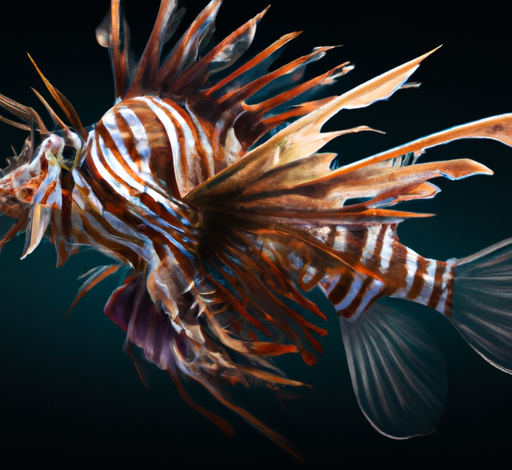Lionfish Species Profile

Overview of Lionfish Species: Natural History and Distribution
Lionfish (Pterois spp.) are a species of venomous fish native to the Indo-Pacific region. They are characterized by their distinctive red, white, and black stripes, as well as their long, fan-like fins. Lionfish are members of the Scorpaenidae family, which includes other venomous fish such as stonefish and scorpionfish.
Lionfish have a wide natural range, extending from the Red Sea and East Africa to the central Pacific Ocean. They inhabit coral reefs, mangroves, and seagrass beds in shallow waters, typically at depths of less than 100 feet. Lionfish are opportunistic predators, feeding on a variety of small fish and invertebrates such as shrimp, crabs, and mollusks. They are also known to consume smaller lionfish, which can lead to competition for resources and population control.
Lionfish are highly adaptable and can live in a variety of habitats. They are voracious predators, capable of consuming prey up to two-thirds their own size. Their diet is largely composed of small fish and invertebrates, but they have also been known to feed on larger prey such as squid and octopus. Lionfish have the ability to rapidly expand their gill covers to create a vacuum-like suction that allows them to capture prey in an instant.
In recent years, lionfish have become an invasive species in many parts of the
Impacts of Lionfish on Native Ecosystems
The lionfish (Pterois volitans) is an invasive species native to the Indo-Pacific region that has been wreaking havoc on native ecosystems in the Atlantic and Caribbean since its introduction in the 1980s. The lionfish is a voracious predator that preys on a wide variety of fish, crustaceans, and mollusks, and its presence has caused significant disruption to the balance of marine ecosystems throughout the region.
The lionfish has a number of characteristics that make it well-suited to outcompeting native species. Its venomous spines deter predators, while its large mouth and stomach allow it to consume prey larger than itself. It is also highly fecund, with females capable of producing up to 30,000 eggs every four days. This combination of traits has enabled the lionfish to spread rapidly throughout the region, with populations now found from North Carolina to Brazil.
The impacts of the lionfish on native ecosystems have been profound. In addition to preying on native species, the lionfish has been shown to alter the behavior of other fish, leading to reductions in their populations. Furthermore, its presence has caused a shift in the structure of coral reef communities, with fewer large predators and an increase in smaller prey species. This has led to a decrease in biodiversity, as well as an increase in algal growth due to the absence of herbivorous fish.
The lionfish’s presence has also had economic
Lionfish as an Invasive Species
The lionfish (Pterois volitans) is a species of fish native to the Indo-Pacific region that has become an established invasive species in the Atlantic Ocean, Caribbean Sea, and Mediterranean Sea. It is a member of the scorpionfish family and has distinctive red, white, and black stripes along its body.
Lionfish are voracious predators that feed on a wide variety of fish, crustaceans, and other invertebrates. They have large mouths with 18 venomous spines that can deliver a painful sting if touched. These spines also make them difficult for predators to eat, allowing them to outcompete native fish species for food and habitat
Lionfish reproduce rapidly and have no predators in their invasive range They can lay up 30,000 eggs every four days and have been known to reach densities of up to 1,000 individuals per acre. This has caused a significant decline in native fish populations, leading to a decrease in biodiversity and a disruption of the food web.
In addition to their predatory behavior, lionfish are highly adaptable and can thrive in a wide range of habitats. They are often found in shallow waters near coral reefs and can tolerate temperatures from 50-86 degrees Fahrenheit. This makes them difficult to control and has allowed them to spread quickly throughout the Atlantic Ocean.
Lionfish are an invasive species that have caused significant damage to marine ecosystems in the Atlantic Ocean,
Management Strategies for Controlling Lionfish Populations
Management strategies for controlling lionfish populations are essential for maintaining healthy ecosystems in the world’s oceans. Lionfish are a non-native species that have been introduced to the Atlantic and Caribbean regions, where they have become an invasive species. They are voracious predators, consuming large amounts of native fish and invertebrates, and they reproduce quickly, making them difficult to control.
Fortunately, there are several management strategies that can be employed to reduce lionfish populations and limit their impacts on native species. One of the most effective strategies is targeted harvesting. This involves the use of divers or traps to capture lionfish and remove them from the environment. This is especially effective when done on a large scale, as it can significantly reduce the number of lionfish in a given area.
Another strategy for controlling lionfish populations is the use of public education campaigns. These campaigns help raise awareness about the dangers of lionfish and encourage people to take part in removal efforts. They can also provide information about the best methods for capturing lionfish and how to safely handle them.
In addition, research into the biology and ecology of lionfish can help inform management strategies. Understanding the behavior of lionfish and their impacts on native species can help inform decisions about how best to manage their populations. For example, research may indicate that certain areas should be closed off to fishing to protect native species from predation by lionfish.
Finally, habitat restoration efforts can help reduce the impacts
Potential Benefits of Lionfish as a Food Source
Lionfish are an increasingly popular food source due to their unique flavor and texture. These fish, native to the Indo-Pacific region, have become a popular delicacy in many parts of the world. In addition to their delicious taste, there are many potential benefits to consuming lionfish.
First, lionfish are high in protein and low in fat. This makes them an ideal choice for those looking to maintain a healthy diet. They are also rich in essential vitamins and minerals, such as vitamin A, vitamin C, magnesium, and potassium. These nutrients can help support overall health and well-being.
Second, lionfish are a sustainable seafood option. They are not overfished, and they have a low impact on the environment. This makes them an excellent choice for those looking to reduce their carbon footprint.
Third, lionfish can be prepared in a variety of ways. They can be grilled, fried, steamed, or even made into ceviche. This makes them a versatile ingredient that can be used in many different dishes.
Finally, lionfish are an affordable seafood option. They are typically less expensive than other types of fish, making them accessible to most people.
Overall, lionfish offer a variety of potential benefits as a food source. They are high in protein and low in fat, they are sustainable, they can be prepared in a variety of ways, and they are affordable. For these reasons, they are becoming
Excerpt
onfish is a species of venomous marine fish native to the Indo-Pacific region. It is characterized by its red, white, and black stripes and its spiny fins. It is a popular aquarium fish, but its venomous spines make it a dangerous predator in the wild. It has become an invasive species in the Atlantic Ocean, where it has no natural predators.
Overview of Lionfish Species: Natural History and Distribution
Lionfish (Pterois spp.) are a species of venomous fish native to the Indo-Pacific region. They are characterized by their distinctive red, white, and black stripes, as well as their long, fan-like fins. Lionfish are members of the Scorpaenidae family, which includes other venomous fish such as stonefish and scorpionfish.
Lionfish have a wide natural range, extending from the Red Sea and East Africa to the central Pacific Ocean. They inhabit coral reefs, mangroves, and seagrass beds in shallow waters, typically at depths of less than 100 feet. Lionfish are opportunistic predators, feeding on a variety of small fish and invertebrates such as shrimp, crabs, and mollusks. They are also known to consume smaller lionfish, which can lead to competition for resources and population control.
Lionfish are highly adaptable and can live in a variety of habitats. They are voracious predators, capable of consuming prey up to two-thirds their own size. Their diet is largely composed of small fish and invertebrates, but they have also been known to feed on larger prey such as squid and octopus. Lionfish have the ability to rapidly expand their gill covers to create a vacuum-like suction that allows them to capture prey in an instant.
In recent years, lionfish have become an invasive species in many parts of the
Impacts of Lionfish on Native Ecosystems
The lionfish (Pterois volitans) is an invasive species native to the Indo-Pacific region that has been wreaking havoc on native ecosystems in the Atlantic and Caribbean since its introduction in the 1980s. The lionfish is a voracious predator that preys on a wide variety of fish, crustaceans, and mollusks, and its presence has caused significant disruption to the balance of marine ecosystems throughout the region.
The lionfish has a number of characteristics that make it well-suited to outcompeting native species. Its venomous spines deter predators, while its large mouth and stomach allow it to consume prey larger than itself. It is also highly fecund, with females capable of producing up to 30,000 eggs every four days. This combination of traits has enabled the lionfish to spread rapidly throughout the region, with populations now found from North Carolina to Brazil.
The impacts of the lionfish on native ecosystems have been profound. In addition to preying on native species, the lionfish has been shown to alter the behavior of other fish, leading to reductions in their populations. Furthermore, its presence has caused a shift in the structure of coral reef communities, with fewer large predators and an increase in smaller prey species. This has led to a decrease in biodiversity, as well as an increase in algal growth due to the absence of herbivorous fish.
The lionfish’s presence has also had economic
Lionfish as an Invasive Species
The lionfish (Pterois volitans) is a species of fish native to the Indo-Pacific region that has become an established invasive species in the Atlantic Ocean, Caribbean Sea, and Mediterranean Sea. It is a member of the scorpionfish family and has distinctive red, white, and black stripes along its body.
Lionfish are voracious predators that feed on a wide variety of fish, crustaceans, and other invertebrates. They have large mouths with 18 venomous spines that can deliver a painful sting if touched. These spines also make them difficult for predators to eat, allowing them to outcompete native fish species for food and habitat
Lionfish reproduce rapidly and have no predators in their invasive range They can lay up 30,000 eggs every four days and have been known to reach densities of up to 1,000 individuals per acre. This has caused a significant decline in native fish populations, leading to a decrease in biodiversity and a disruption of the food web.
In addition to their predatory behavior, lionfish are highly adaptable and can thrive in a wide range of habitats. They are often found in shallow waters near coral reefs and can tolerate temperatures from 50-86 degrees Fahrenheit. This makes them difficult to control and has allowed them to spread quickly throughout the Atlantic Ocean.
Lionfish are an invasive species that have caused significant damage to marine ecosystems in the Atlantic Ocean,
Management Strategies for Controlling Lionfish Populations
Management strategies for controlling lionfish populations are essential for maintaining healthy ecosystems in the world’s oceans. Lionfish are a non-native species that have been introduced to the Atlantic and Caribbean regions, where they have become an invasive species. They are voracious predators, consuming large amounts of native fish and invertebrates, and they reproduce quickly, making them difficult to control.
Fortunately, there are several management strategies that can be employed to reduce lionfish populations and limit their impacts on native species. One of the most effective strategies is targeted harvesting. This involves the use of divers or traps to capture lionfish and remove them from the environment. This is especially effective when done on a large scale, as it can significantly reduce the number of lionfish in a given area.
Another strategy for controlling lionfish populations is the use of public education campaigns. These campaigns help raise awareness about the dangers of lionfish and encourage people to take part in removal efforts. They can also provide information about the best methods for capturing lionfish and how to safely handle them.
In addition, research into the biology and ecology of lionfish can help inform management strategies. Understanding the behavior of lionfish and their impacts on native species can help inform decisions about how best to manage their populations. For example, research may indicate that certain areas should be closed off to fishing to protect native species from predation by lionfish.
Finally, habitat restoration efforts can help reduce the impacts
Potential Benefits of Lionfish as a Food Source
Lionfish are an increasingly popular food source due to their unique flavor and texture. These fish, native to the Indo-Pacific region, have become a popular delicacy in many parts of the world. In addition to their delicious taste, there are many potential benefits to consuming lionfish.
First, lionfish are high in protein and low in fat. This makes them an ideal choice for those looking to maintain a healthy diet. They are also rich in essential vitamins and minerals, such as vitamin A, vitamin C, magnesium, and potassium. These nutrients can help support overall health and well-being.
Second, lionfish are a sustainable seafood option. They are not overfished, and they have a low impact on the environment. This makes them an excellent choice for those looking to reduce their carbon footprint.
Third, lionfish can be prepared in a variety of ways. They can be grilled, fried, steamed, or even made into ceviche. This makes them a versatile ingredient that can be used in many different dishes.
Finally, lionfish are an affordable seafood option. They are typically less expensive than other types of fish, making them accessible to most people.
Overall, lionfish offer a variety of potential benefits as a food source. They are high in protein and low in fat, they are sustainable, they can be prepared in a variety of ways, and they are affordable. For these reasons, they are becoming
Excerpt
onfish is a species of venomous marine fish native to the Indo-Pacific region. It is characterized by its red, white, and black stripes and its spiny fins. It is a popular aquarium fish, but its venomous spines make it a dangerous predator in the wild. It has become an invasive species in the Atlantic Ocean, where it has no natural predators.



